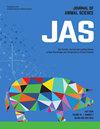PSXIII-19 多种碳水化合物复合酶的水平对饲养场牛消化率和瘤胃发酵特性的影响
IF 2.9
2区 农林科学
Q1 AGRICULTURE, DAIRY & ANIMAL SCIENCE
引用次数: 0
摘要
另一方面,玉米乙醇副产品对营养物质消化率的影响仍存在争议。我们假设,补充复合酶可提高接受育成日粮的饲养场牛的养分消化率并增加瘤胃 pH 值,而添加 DFS(玉米干糠/纤维加蒸馏水溶解物)对瘤胃发酵和养分消化率没有影响。本研究的目的是评估使用多种复合碳水化合物酶的剂量和添加 DFS 对营养物质消化率和瘤胃发酵的影响。在 2 × 3 因子排列的随机完全区组设计中使用了反刍插管内洛尔阉牛 [n = 30;初始体重 (BW) = 250 千克]。因子 1 的定义是 DFS 的含量[干物质(DM)的 15%或 45%],因子 2 是多糖酶复合物的剂量(0、0.75 和 1.0 克/10 千克 DM)。日粮中含有 8.5% 甘蔗渣、44% 或 73% 磨碎的燧石玉米、15% 或 45% DFS、0.5% 或 1.5% 尿素和 2% 矿物质混合物以及莫能菌素,以及相应的复合酶剂量。消化率评估是根据研究第 18-22 天的养分消耗量(提供的和未消耗的饲料)和粪便总产量进行的。在研究的第 23 天,每隔 3 小时收集一次瘤胃液,并对样本进行分析,以确定瘤胃液的 pH 值、挥发性脂肪酸(VFA)比例和氨氮浓度。采用正交对比法评估复合酶剂量的影响,显著性水平为 5%。进行了以下两种对比试验蛋白质消化率存在交互作用(P ≤ 0.05)。在含有 45% DFS 的日粮中,添加多淀粉酶复合物可提高粗蛋白(CP)消化率,而对含有 15% DFS 的日粮没有影响。饲喂复合酶可提高(P ≤ 0.05)醚提取物的消化率。饲喂 45% 和 15% DFS 对营养物质的消化率没有影响(P ≥ 0.05)。在瘤胃发酵变量方面,DFS添加量和酶的剂量没有相互作用。添加 DFS 对 VFA 和瘤胃氨没有影响;但添加 45% 的 DFS 会增加瘤胃 pH 值(6.40 对 6.23)。多聚碳水化合物酶复合物的剂量对瘤胃 pH 值、VFA 和氨浓度没有影响,但降低了乙酸盐:丙酸盐的比例。总之,复合酶对养分消化率的影响较小,但能改善瘤胃发酵,而饲喂日粮中 45% 的 DFS 对养分消化率没有影响,但能提高瘤胃 pH 值。本文章由计算机程序翻译,如有差异,请以英文原文为准。
PSXIII-19 Levels of multicarbohydrase complexes on digestibility and rumen fermentation characteristics for feedlot cattle
Feeding exogenous enzymes has the potential to increase the digestibility of nutrients and modify rumen fermentation in diets for feedlot cattle, on the other hand, the effect of the inclusion of corn ethanol co-products on nutrient digestibility is still controversial. We hypothesized that the supplementation of enzyme complex improves nutrient digestibility and increases ruminal pH of feedlot cattle receiving a finishing diet and the inclusion of DFS (corn dry bran/fiber plus distillers solubles) has no effect on rumen fermentation and nutrients digestibility. The objective of this study was to evaluate the use of doses of multicarbohydrase complexes and the inclusion of DFS on nutrient digestibility and rumen fermentation. Ruminally cannulated Nellore steers [n = 30; Initial body weight (BW) = 250 kg] were used in a randomized complete block design in a 2 × 3 factorial arrangement. Factor 1 was defined by the inclusion of DFS [15% or 45% of dry matter (DM)], and factor 2 was the doses of multicarbohydrase complexes (0, 0.75 and 1.0 g/10 kg of DM). The diets contained 8.5% sugar cane bagasse, 44 or 73% ground flint corn, 15 or 45% DFS, 0.5 or 1.5% urea and 2% mineral mix plus monensin with the respective enzyme complex doses. The digestibility assessment was carried out based on the assessment of nutrient consumption (offered and non-consumed feed) and total feces production on d 18 to 22 of the study. Ruminal fluid collection was carried out on d 23 of the study, every 3 h, and samples were analyzed to determine ruminal fluid pH, volatile fatty acids (VFA) proportion and ammonia nitrogen concentration. Orthogonal contrasts were performed to evaluate the effects of enzyme complex doses with a significance level of 5%. Two contrasts were tested to compare: 1) 0 g of enzyme vs. inclusion of enzyme, and 2) 0.75 g of enzyme vs. 1.0 g. There was an interaction (P ≤ 0.05) for protein digestibility. The inclusion of multicarbohydrase complexes increased crude protein (CP) digestibility in diets with 45% DFS, with no effect on diets containing 15% DFS. Feeding the enzyme complex increased (P ≤ 0.05) the ether extract digestibility. Feeding 45 vs 15% DFS had no effect on the digestibility of nutrients (P ≥ 0.05). There was no DFS inclusion and doses of enzymes interaction for ruminal fermentation variables. The DFS inclusion did not affect the VFA and ruminal ammonia; however, the inclusion of 45% DFS increased the ruminal pH (6.40 vs. 6.23). The doses of multicarbohydrase complexes did not affect the ruminal pH, VFA and ammonia concentration; however, decreased the acetate:propionate ratio. In conclusion, the enzyme complex had minor effects on nutrient digestibility but improved rumen fermentation, while feeding 45% DFS in the diet had no effect on nutrient digestibility and increased rumen pH.
求助全文
通过发布文献求助,成功后即可免费获取论文全文。
去求助
来源期刊

Journal of animal science
农林科学-奶制品与动物科学
CiteScore
4.80
自引率
12.10%
发文量
1589
审稿时长
3 months
期刊介绍:
The Journal of Animal Science (JAS) is the premier journal for animal science and serves as the leading source of new knowledge and perspective in this area. JAS publishes more than 500 fully reviewed research articles, invited reviews, technical notes, and letters to the editor each year.
Articles published in JAS encompass a broad range of research topics in animal production and fundamental aspects of genetics, nutrition, physiology, and preparation and utilization of animal products. Articles typically report research with beef cattle, companion animals, goats, horses, pigs, and sheep; however, studies involving other farm animals, aquatic and wildlife species, and laboratory animal species that address fundamental questions related to livestock and companion animal biology will be considered for publication.
 求助内容:
求助内容: 应助结果提醒方式:
应助结果提醒方式:


